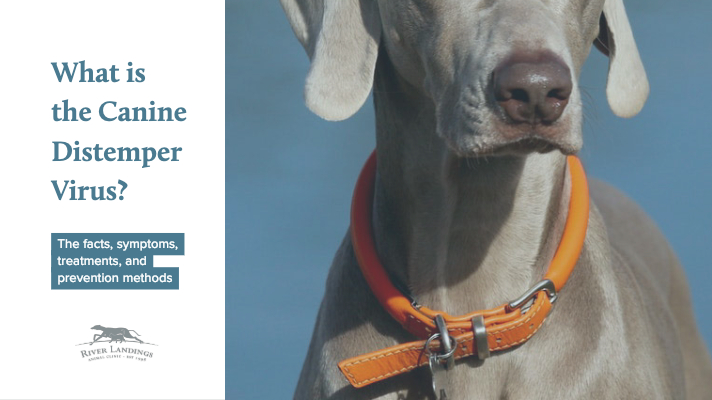Distemper is one of the most serious diseases your dog can get. It is also one of the most preventable. Here are the facts, symptoms, treatment options, and prevention methods that every dog owner needs to know about distemper.
What Is Canine Distemper?
Canine distemper should sound familiar to you if your dog is up-to-date on his vaccinations. Veterinarians consider the distemper vaccine to be a core vaccination, along with the parvovirus and rabies vaccines.
The disease is highly contagious and potentially lethal. A paramyxovirus causes distemper in dogs, and it is closely related to the measles and rinderpest viruses. It causes severe illness in the host by attacking multiple body systems, resulting in a widespread infection that is difficult to treat.
How Is Canine Distemper Spread?
There are three ways dogs can get canine distemper:
Through direct contact with an infected animal or object
Through airborne exposure
Through the placenta
Canine distemper is spread through direct contact or airborne exposure, rather like the common cold in humans. When an infected dog or wild animal coughs, sneezes, or barks, he releases aerosol droplets into the environment, infecting nearby animals and surfaces, like food and water bowls.
The good news is that the virus does not last long in the environment and can be destroyed by most disinfectants. The bad news is that distemper-infected dogs can shed the virus for up to several months, putting dogs around them at risk.
Dogs are not the only animals that can get distemper. Wild animals like raccoons, foxes, wolves, coyotes, skunks, ferrets, and mink can also get the distemper virus. This means that an outbreak of distemper in the local wildlife population can put dogs at risk for catching the disease even if they do not come into contact with other dogs.
Female dogs can also spread the virus through the placenta to their puppies, which is one of the reasons why it is important to fully vaccinate any dog you plan to breed.
What Are the Symptoms of Canine Distemper?
Distemper dogs experience a wide range of symptoms depending on how advanced the disease is in their bodies. Once a dog becomes infected, the virus initially replicates in the lymphatic tissue of the respiratory tract before moving on to infect the rest of the dog’s lymphatic tissue, the respiratory tract, the GI tract, the urogenital epithelium, the central nervous system, and optic nerves. This results in two stages of symptoms.
Stage One
The first symptom of distemper in dogs is usually watery to pus-like discharge from his eyes, followed by fever, loss of appetite, and clear nasal discharge. Most dogs develop a fever approximately 3-to-6 days after being infected, but the initial symptoms depend on the severity of the case and how the patient reacts to it. In general, the symptoms associated with distemper in dogs during the first stages of infection are:
Fever
Clear nasal discharge
Purulent eye discharge
Lethargy
Anorexia
Coughing
Vomiting
Diarrhea
Pustular dermatitis (rarely)
Inflammation of the brain and spinal cord
If a dog infected with distemper survives the acute stage of the illness, he may also develop hyperkeratosis of the paw pads and nose, which gives distemper the nickname “hard pad disease.” This distemper symptom causes the pads of a dog’s feet to harden and enlarge and is uncomfortable.
One of the other risks associated with distemper in dogs is a secondary bacterial infection that attacks when a dog’s immune system is compromised by the distemper virus. Secondary bacterial infections can cause respiratory and GI symptoms, including:
Vomiting
Diarrhea
Difficulty breathing
Change in respiratory rate
Pneumonia
Stage Two
Some dogs develop neurological signs as the disease progresses and attacks the central nervous system. These signs are particularly disturbing for owners.
Head tilt
Circling
Partial or full paralysis
Seizures
Nystagmus (repetitive eye movements)
Muscle twitching
Convulsions with increased salivation and chewing motions
Death
Distemper in dogs presents with some or all of these symptoms, depending on the severity of the case. According to the American Veterinary Medical Association (AVMA), “distemper is often fatal, and dogs that survive usually have permanent, irreparable nervous system damage.”
Is my dog at risk for Distemper?
Distemper is a risk to all dogs, but unvaccinated dogs and puppies under four months old are particularly susceptible to canine distemper. If your puppy shows any symptoms of distemper, call your vet immediately.
How to Treat Canine Distemper
There is no cure for canine distemper. Veterinarians diagnose distemper through a combination of clinical signs and diagnostic tests, or through a postmortem necropsy. Once diagnosed, care is purely supportive. Veterinarians treat the diarrhea, vomiting, and neurological symptoms, prevent dehydration, and try to prevent secondary infections. Most vets recommend that dogs be hospitalized and separated from other dogs to prevent the spread of infection.
The survival rate and length of infection depend on the strain of the virus and on the strength of the dog’s immune system. Some cases resolve as quickly as 10 days. Other cases may exhibit neurological symptoms for weeks and even months afterward.
Preventing Canine Distemper
Canine distemper is entirely preventable. There are several things you can do to prevent distemper in dogs:
Make sure your puppy gets the full series of distemper vaccinations
Keep distemper vaccinations up-to-date throughout your dog’s life and avoid any gaps in vaccinations
Keep your dog away from infected animals and wildlife
Vaccinate pet ferrets for distemper
Be careful socializing your puppy or unvaccinated dog, especially in areas where dogs congregate, like dog parks, classes, and doggy day care
By following these steps, you can keep your dog safe from distemper. If you have more questions about distemper in dogs, talk to your veterinarian, and call your vet immediately if you suspect your dog might be showing symptoms of distemper.









